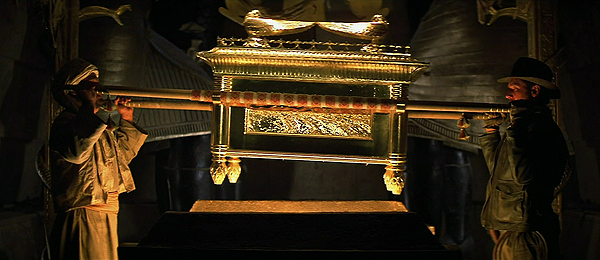
“Well, I mean that for nearly three thousand years man has been searching for the lost ark. It’s not something to be taken lightly. No one knows its secrets. It’s like nothing you’ve ever gone after before.” —Marcus Brody
Along with developing ideas for Star Wars, George Lucas had an idea to recreate the serials of the 1930’s following the adventures of an archaeologist. George told this idea to Phillip Kaufman who suggested the idea of the Lost Ark of the Covenant as the McGuffin. (A term coined by Alfred Hitchcock in which a MacGuffin is a plot device in the form of some goal, desired object, or another motivator that the protagonist pursues, often with little or no narrative explanation. The MacGuffin’s importance to the plot is not the object itself, but rather its effect on the characters and their motivations.) Shelving Raiders of the Lost Ark for a bit, Lucas went on to make Star Wars, but when he circled back around to flesh out the adventures of Indiana Jones. He kept the idea for the Ark of the Covenant resulting in Kaufman receiving a shared “story by” credit for the movie.
The Bible describes the Ark in great detail, giving the Raiders prop builders an outline to follow.
Exodus 37:1-9
Now Bezalel made the ark of acacia wood; its length was two and a half cubits, and its width one and a half cubits, and its height one and a half cubits; and he overlaid it with pure gold inside and out, and made a gold molding for it all around. He cast four rings of gold for it on its four feet; even two rings on one side of it, and two rings on the other side of it.
He made poles of acacia wood and overlaid them with gold. He put the poles into the rings on the sides of the ark, to carry it. He made a mercy seat of pure gold, two and a half cubits long and one and a half cubits wide. He made two cherubim of gold; he made them of hammered work at the two ends of the mercy seat; one cherub at the one end and one cherub at the other end; he made the cherubim of one piece with the mercy seat at the two ends. The cherubim had their wings spread upward, covering the mercy seat with their wings, with their faces toward each other; the faces of the cherubim were toward the mercy seat.
The Ark has been depicted in art for centuries. Some of the most famous and influential images were painted by Jacques Tissot. His paintings would seem to be the basis for the design of the Ark as seen in 1951’s David and Bathsheba.
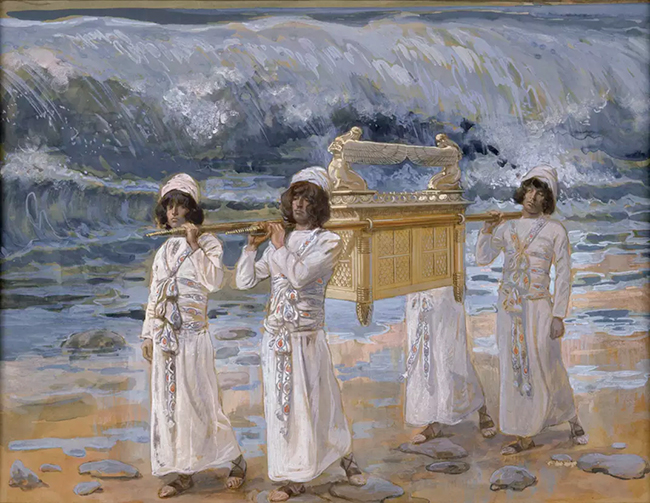
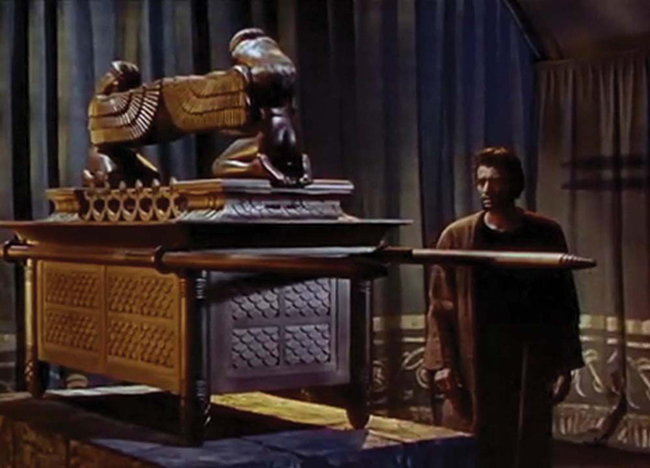
During preproduction of Raiders of the Lost Ark, Joe Johnston created concept art depicting the Ark.
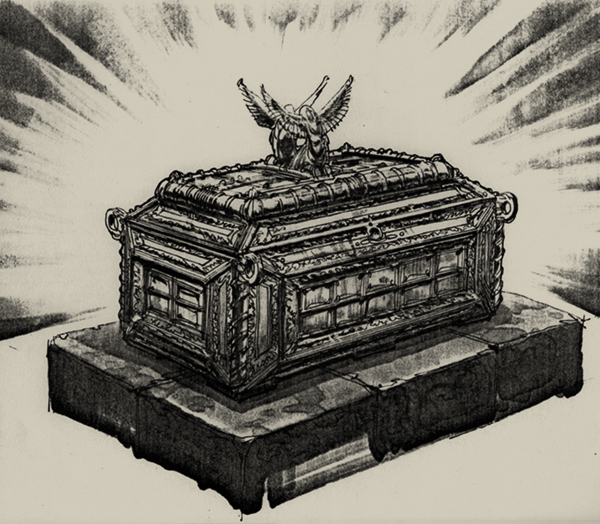
Under the direction of Production Designer Norman Reynolds, Brian Short and Brian Muir were tasked with sculpting the art for the Ark. Short created the winged cherubs and Muir the lid and side wall reliefs for the Raiders version of the Ark. The Ark was “gold plated” using the same vacuum metallization process used for the droid C-3PO in Star Wars. The final product stayed much closer in look to the Tissot painting than to the preproduction art of Johnston.
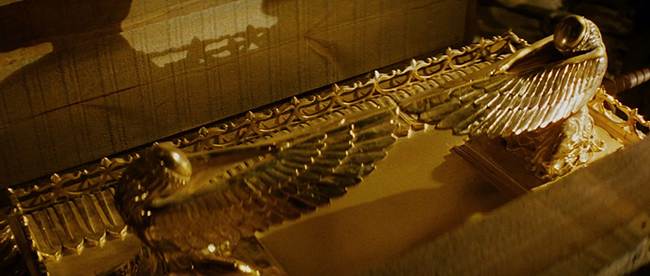
Dimensions: Ark of the Covenant, prop, 71 x 234 x 94 cm.
During filming it was not always practical, nor necessary, to use the full Ark prop. During scenes shot in the Well of Souls, a cutout on wooden sticks was used for the dramatic shadow image of Indy and Sallah carrying the Ark. Such is movie magic.
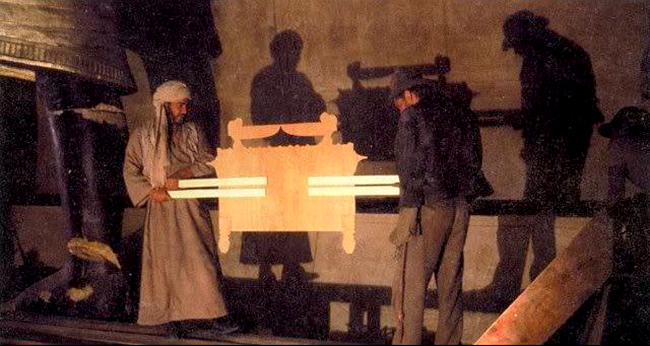
Sometimes props are created and not used, other times they are repurposed for the film and used in other ways. The preproduction artwork of the Ark that Joe Johnston created was actually built and used during filming. While his version varied significantly from the main prop it was used to accommodate the lighting and pyrotechnics during the climactic scene opening the Ark. While barely visible on screen it can still be seen by eagle-eyed viewers who can operate the pause button effectively.
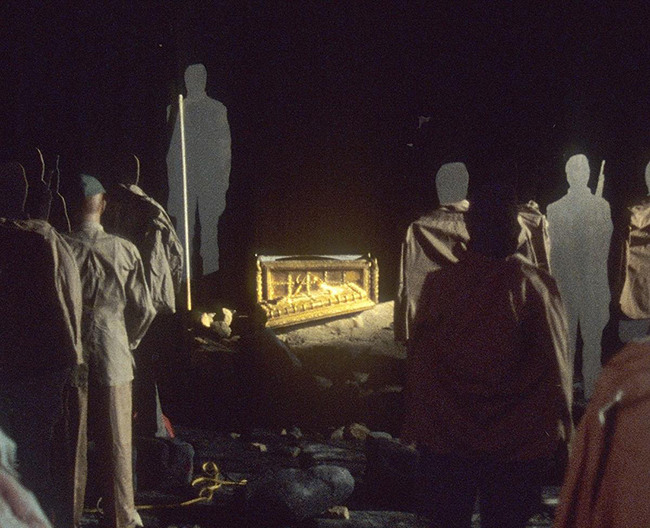
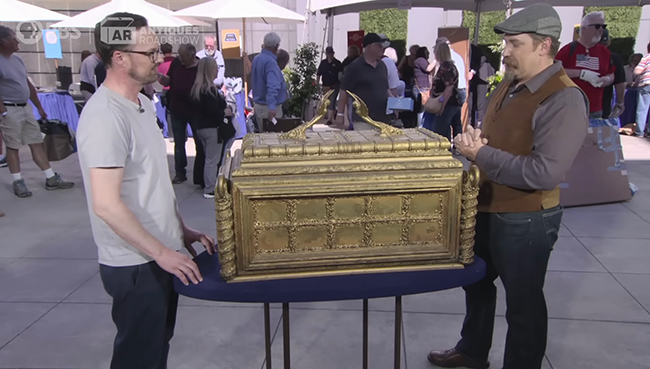
Movie magic isn’t limited to what you see on screen. Sound Designer, Ben Burtt, wanted to create an imposing sound for the lid of the Ark being removed. In the end, he found the best option was sliding the lid off of a toilet tank in an echoey bathroom, giving him just the quality he was looking (listening) for. To create the otherworldly wavering tones when the Ark is opened, Burtt used the same ARP 2600 electronic synthesizer he used for creating R2-D2’s vocalizations. Animal roars, dolphins, sea lions and human voices were all mixed for the sound of the spirits flying out of the Ark. Sparking and electrical sounds were recorded using the original lab equipment from the 1931 Frankenstein film.
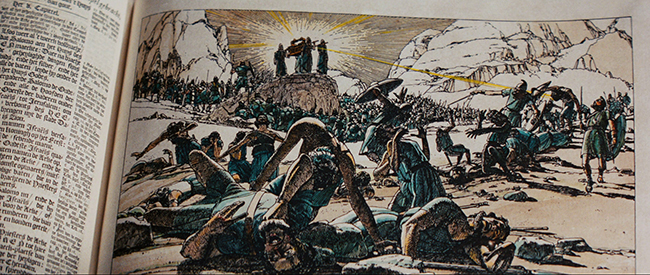
“[pointing to a beam of light] Uh, now what’s that supposed to be coming out of there?” —Colonel Musgrove
“Lightning. Fire. Power of God or something.” —Indy
“I’m beginning to understand Hitler’s interest in this.” —Major Eaton
“Oh, yes. The Bible speaks of the Ark leveling mountains and laying waste to entire regions. An army which carries the Ark before it…is invincible.” —Brody
1 Samuel 6:19-21
The descendants of Jeconiah did not rejoice with the people of Beth-shemesh when they greeted [a] the ark of the Lord; and he killed seventy men of them. The people mourned because the Lord had made a great slaughter among the people. Then the people of Beth-shemesh said, “Who is able to stand before the Lord, this holy God? To whom shall he go so that we may be rid of him?”
1 Samuel 5:1-4
When the Philistines captured the ark of God, they brought it from Ebenezer to Ashdod; then the Philistines took the ark of God and brought it into the house of Dagon and placed it beside Dagon. When the people of Ashdod rose early the next day, there was Dagon, fallen on his face to the ground before the ark of the LORD. So they took Dagon and put him back in his place. But when they rose early on the next morning, Dagon had fallen on his face to the ground before the ark of the LORD, and the head of Dagon and both his hands were lying cut off upon the threshold; only the trunk of [a] Dagon was left to him.
This Bible reference to Dagon bares a close description to the Nazi symbol being burned off the side of the crate while the Ark is being transported.
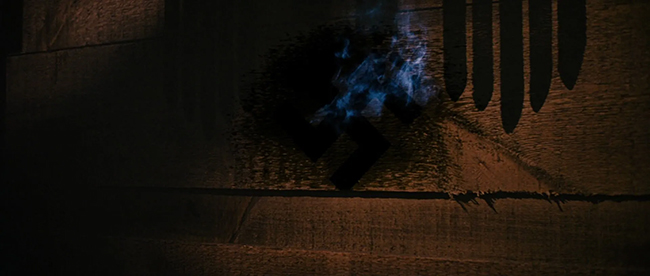
Relying on the idea that “a picture is worth 1,000 words,” in the exposition scene in which Indiana Jones explains to the power of the Ark, George Lucas wanted an image to use to introduce the audience to the Ark as well as a way to portray the power the Ark was supposed to contain. Having worked with Ralph McQuarrie on Star Wars, Lucas hired McQuarrie to create an illustration for the Bible page to be used in the scene.
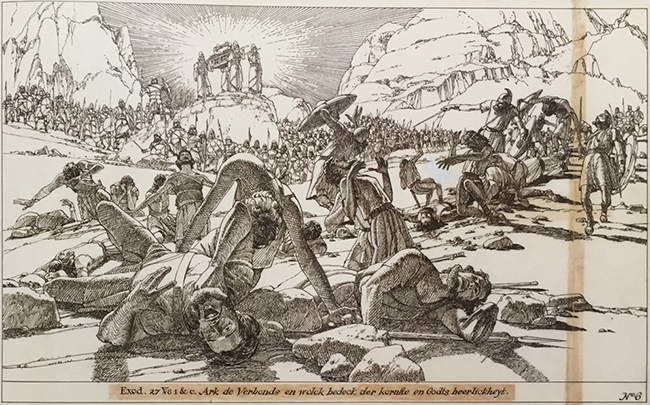
In Raiders of the Lost Ark, the Ark was found in the Egyptian city of Tanis, however, there are many ideas as to what happened to the Ark of the Bible. Professor John Day of the University of Oxford presents the following twelve views on what happened to the Ark of the Covenant, ranging from ancient Jewish and other medieval views, to modern scholarly critical views (from the 19th century up to the present), to modern unconventional views:
1. Ark Hidden on Mt. Gerizim in the Time of Eli or Moses
2. Ark Taken to Ethiopia in the Time of Solomon
3. Ark Taken by Pharaoh Shishak/Sheshonq (the view within Raiders of the Lost Ark)
4. Ark Removed by Deliberate Internal Action soon after the Disruption of the United Monarchy
5. Ark Removed by King Jehoash of Israel
6. Ark Removed by King Ahaz of Judah
7. Ark Removed by King Hezekiah of Judah
8. Ark Removed by King Manasseh of Judah
9. Ark Removed or Hidden by King Josiah of Judah
10. Ark Hidden by the prophet Jeremiah
11. Ark Carried away by the Babylonians under Nebuchadrezzar
12. Ark Destroyed by the Babylonians under Nebuchadrezzar (within the fire and destruction of Solomon’s Temple, this is the view Professor Day considers most likely)
John Day, “Whatever Happened to the Ark of the Covenant?” in Temple and Worship in Biblical Israel, ed. by John Day (New York: T&T Clark, 2007), 250-270.
By the end of Raiders of the Lost Ark, “top men” of the US government decide the Ark is too dangerous and hide the Ark away in a warehouse containing all of the government’s greatest secrets.

But the story of the Ark didn’t end there!
During the filming of Indiana Jones and the Kingdom of the Crystal Skull, the original Ark prop was brought out of the Lucasfilm Archives for a brief cameo during the introduction of the movie in Warehouse 51. According to the book, The Complete Making of Indiana Jones, the prop required its own security team and special insurance while on the set as it was truly irreplaceable should something happen to it! (No, there are no reports of the prop burning through its shipping crate in transit.)

You know you’ve made a legendary prop when it is used in countless documentaries decades after your movie has wrapped. The Ark of the Covenant prop in Raiders of the Lost Ark probably ranks as the most famous recreation of an ancient relic in movie history. A number of documentaries about the Ark of the Covenant have used footage from Raiders to illustrate what the Ark looked like in antiquity for viewers, and at the same time piqued the pop culture interest of the audience.
